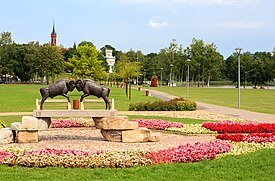Druskininkai
Druskininkai | |
|---|---|
City | |
| |
|
UTC+3 (EEST) | |
| Website | druskininkusavivaldybe |
 | |
Druskininkai (Lithuanian pronunciation:
Name
The exact origin of the city name is not certain, but it is derived from the
Geography
The city is located at the Ratnyčia River
History
This article needs additional citations for verification. (February 2024) |

According to some sources the site of present-day Druskininkai was inhabited by local
The first written mention of Druskininkai dates back to 1636. The name of the city suggests that the local population collected
After the
In June 1887, a Jewish national conference was held in Druskininkai led by
By the beginning of the 20th century the Druskininkai spa was one of the most popular resorts in the area and a place of summer residence for the middle class of Vilnius, Warsaw and Moscow.[citation needed]
After
After
Landmarks and culture


Despite damage inflicted during World War I, the city features houses and villas reflecting all periods of its development - Russian, Polish and Lithuanian.
The first water park in Lithuania was opened in Druskininkai on 26 December 2006.
The Snow Arena (construction completed in August 2011) is one of the biggest indoor skiing slopes in Europe, with a year-round indoor slope length of 460 metres, width up to 63 metres, and a height difference of 65.65 metres. In addition there is a seasonal outdoor route of 640 metres. In alpine ski complex Snow Arena works school of skiing and snowboarding DruSkiSchool. There are a number of art and historical museums and galleries in the city. Many cultural events take place, most of them during spring, summer and fall.
During 1896–1910, famous Lithuanian composer and painter Mikalojus Konstantinas Čiurlionis lived and worked in the city. A number of regular events take place at his memorial museum each year.
An annual poetry event, "Druskininkai poetic fall", began in 1985 and attracts authors from all over the world. In 2001,
There is also an annual International Arts Festival 'Druskininkų vasara su M.K.Čiurlioniu' (eng. The summer in Druskininkai with Mikalojus Konstantinas Čiurlionis).
Twin towns — sister cities
Druskininkai is
 Augustów, Poland
Augustów, Poland Elbląg, Poland
Elbląg, Poland Strzelce Opolskie, Poland
Strzelce Opolskie, Poland
Notable residents
- Shmaryahu Yitzchak Bloch (ca. 1862-1923), rabbi
- The father of American actor Charles Bronson (1921-2003), Valteris P. Bučinskis, was born in Druskininkai
- Mikalojus Konstantinas Čiurlionis (1875-1911), lived here
- Jan Czeczot (1796-1847), poet and ethnographer, died here
- Lithuanian Jewishsculptor, was born here
- Lithuanian Communist Partydied here
- Marian Turski (born 1926), journalist and historian
References
- ^ "Lietuvos miestų pavadinimų kilmė – tik upės ir pavardės?" [The origin of Lithuanian city names - only rivers and surnames?]. Delfi (in Lithuanian). 28 January 2012. Retrieved 29 September 2023.
- ^ (in Lithuanian) Apie kurortą Archived May 7, 2009, at the Wayback Machine
- ^ Pioneers of Zionism: Hess, Pinsker, Rulf, Julian H. Schoeps
- ^ Skorowidz miejscowości Rzeczypospolitej Polskiej opracowany na podstawie wyników Pierwszego Powszechnego Spisu Ludności z dn. 30 września 1921 r. I innych źródeł urzędowych T. 10, Województwo Poznańskie. 1926.
- ^ "Tarptautinis bendradarbiavimas". druskininkai.lt (in Lithuanian). Druskininkai. Retrieved 1 September 2019.





